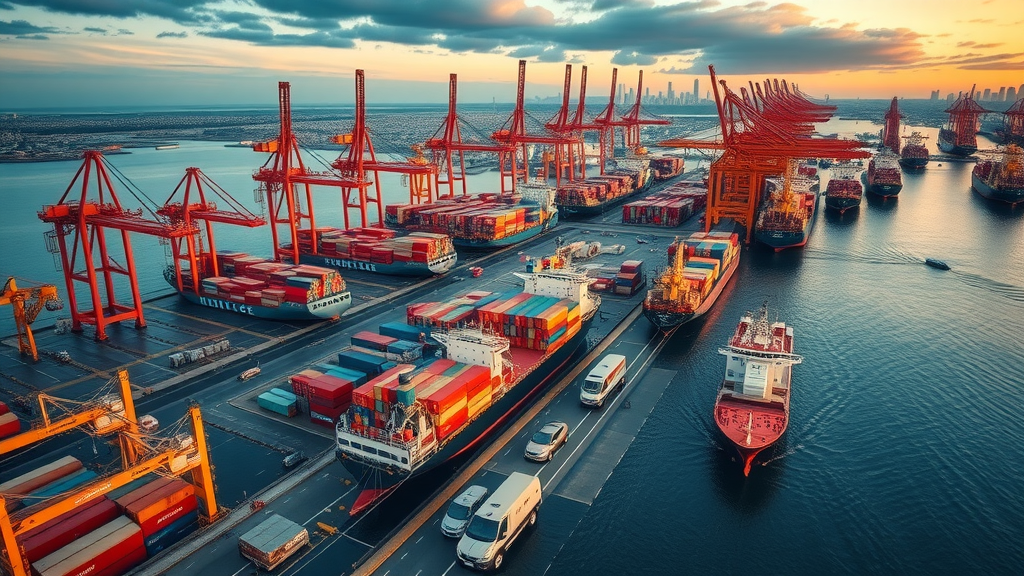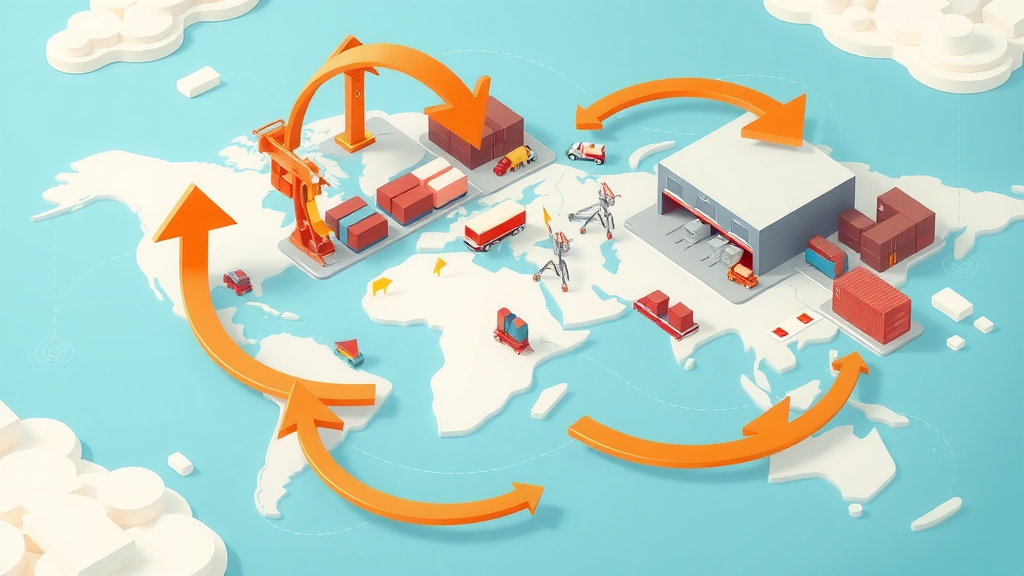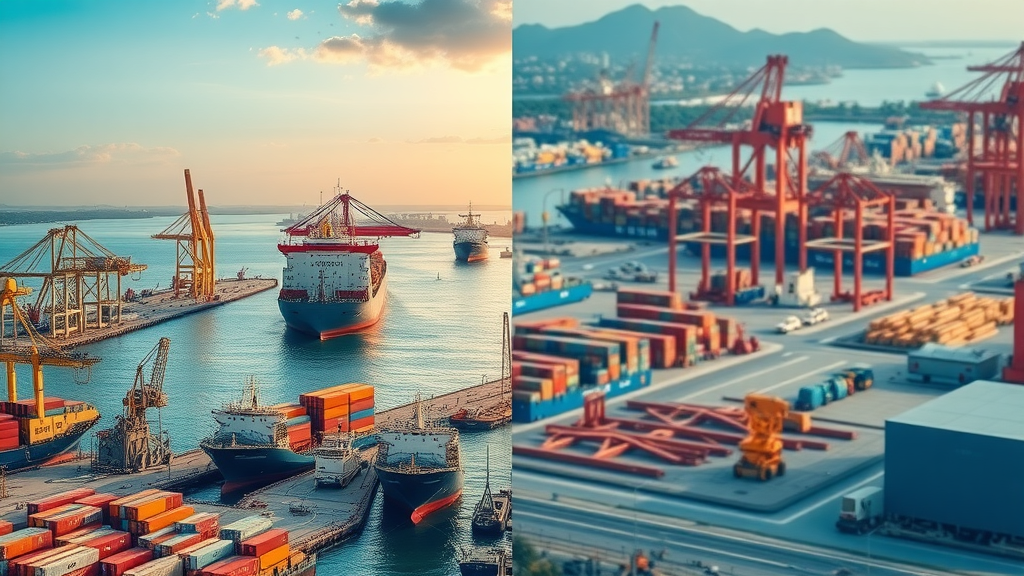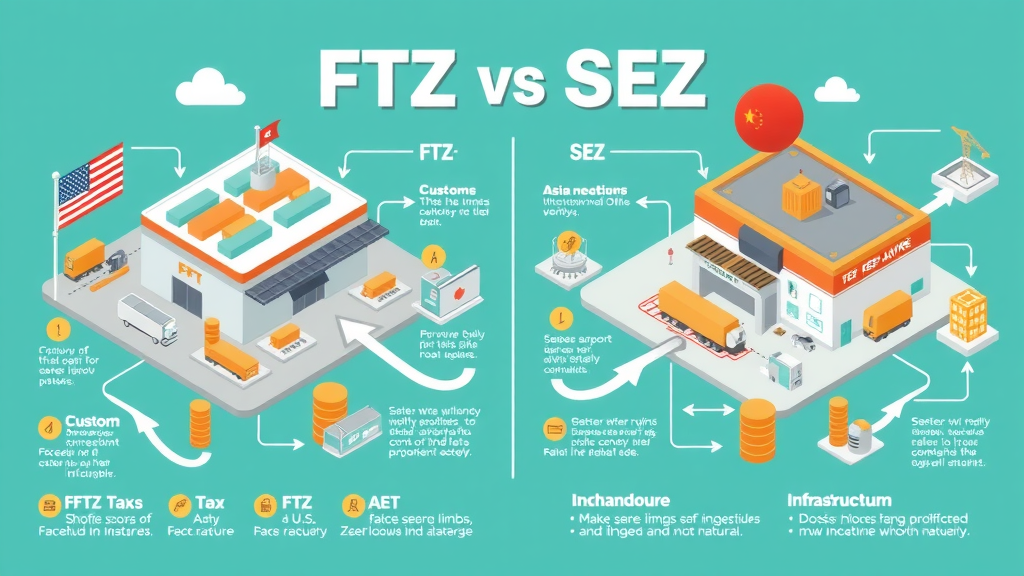Did you know: Businesses in international trade zones can save as much as 30% on logistics and tariffs , fueling faster global expansion and increased profits? Whether you’re a supply chain manager or a growing exporter, understanding how an international trade zone operates can provide a decisive edge. In this guide, we’ll unveil how trade zones drive business growth, clarify the regulatory maze, and show you, step by step, how to use them for maximum benefit. Let’s unlock global opportunity—starting now.

Why International Trade Zones Matter: Surprising Insights that Fuel Global Success
International trade zones are reshaping the way global business operates. A leading trade zone can transform shipping, manufacturing, and supply chain management, making it possible for companies to enter new international markets with lower costs and fewer regulatory barriers. For instance, a multinational logistics company uses a trade zone to import components, assemble finished products, and export them globally, all while deferring customs duties and streamlining paperwork. Trade zones serve as both economic engines and launching pads for innovation, creating jobs, attracting foreign investment, and accelerating economic development in the United States and worldwide.
The true power of an international trade zone lies in its ability to provide a competitive edge. By harnessing FTZs (Foreign Trade Zones) or SEZs (Special Economic Zones), businesses can leverage structured tax incentives, simplified customs procedures, and a magnet site framework for efficient operations. Supply chain improvements become tangible, allowing faster customs clearance, reduction of duty rates, and better tracking of merchandise in a zone. For companies grappling with rising global competition, these features become essential components driving sustainable international growth.
Discover How an International Trade Zone Revolutionizes Global Business
Innovative business leaders are already using trade zones as springboards for broader market access and increased resilience. Consider the impact on a port of entry that serves as a designated magnet site : by clustering related industries and leveraging site-specific benefits, businesses can shorten the supply chain and reduce costs. The international trade zone becomes not just a customs territory, but a powerful ecosystem of logistics, technology, and commerce, helping smaller firms compete on the same stage as global giants. Teams regularly gather in glass-walled offices with real-time data dashboards to optimize shipment flows and react instantly to changes in tariff class or duty rates.

What You’ll Gain from Understanding International Trade Zones
-
Comprehensive knowledge of international trade zone operations
-
Practical strategies to maximize the benefits of trade zones
-
Key differences among global trade zones: FTZ vs. SEZ
-
Expert guidance on regulatory requirements, supply chain integration, and cost savings
International Trade Zone Explained: Definition and Core Concepts
At its core, an international trade zone is a designated geographic area where goods can be imported, handled, manufactured, and re-exported with minimal customs intervention. These zones are purpose-built for companies seeking to minimize tariffs, boost supply chain efficiency, and speed up international trade. The concept applies globally: a foreign trade zone in the United States functions similarly to an SEZ in Asia or an industrial park in Europe, yet each variation offers unique compliance and infrastructure benefits tailored to its specific region.
The economic impact of these trade zones is substantial. By containing a customs territory where duties may be deferred or eliminated, businesses enjoy financial flexibility and room to scale. Moreover, the adoption of digital tracking technologies, such as RFID systems for shipment tracking, means companies can monitor every piece of merchandise in a zone with unmatched precision. Understanding the formal structure (often overseen by an FTZ board or equivalent authority) is crucial for leveraging these advantages while maintaining strict adherence to customs and border protection rules.
The Meaning of Trade Zone and Its Significance in International Trade
A trade zone is more than just a warehouse hub—it’s a regulatory oasis where businesses can transform how they participate in international trade . Within these zones, companies can store goods, assemble components, and add value through light manufacturing, all before those goods officially enter the domestic market. This system is especially powerful for companies with cross-border supply chains, providing relief from immediate customs duties and enabling efficient re-export to other markets. In essence, trade zones democratize access to global supply networks, making it easier for smaller players to establish an international presence and for larger entities to optimize their logistics on a grand scale.

Key Trade Zones in the United States and Worldwide
The United States boasts a robust foreign trade zone framework, with over 250 authorized zones strategically positioned near major ports of entry and industrial centers. Examples include the Port of Los Angeles FTZ, the Dallas/Fort Worth FTZ, and specialized magnet sites that cluster logistics, manufacturing, and retail trade activities for high operational synergy. Globally, Special Economic Zones in countries like China (Shenzhen SEZ), Singapore, and the United Arab Emirates similarly catalyze economic growth by encouraging foreign investment, tax incentives, and state-of-the-art infrastructure.
Each trade zone—whether an FTZ in the United States or an SEZ in Asia—offers its own blend of benefits. American FTZs typically focus on customs and border protection efficiency, while Asian SEZs provide extensive tax breaks and regulatory flexibility, all under the oversight of a zones board or equivalent regulatory body. Understanding this landscape allows businesses to map the best route for their own international expansion. As each region establishes new zones and updates policies, companies must stay informed to maintain compliance and take full advantage of the opportunities presented.
Types of Trade Zones: Foreign Trade Zone vs. Privileged Foreign Area
Navigating the landscape of trade zones involves understanding the primary types, most notably, Foreign Trade Zones (FTZs) and areas with Privileged Foreign status. These designations, often linked to specific site frameworks and magnet sites, each have distinct regulatory and operational advantages. FTZs are common in the United States, functioning under the authority of the FTZ board and offering broad customs relief, while Privileged Foreign Areas may provide tariff or regulatory incentives tied to particular kinds of merchandise in a zone.
The distinction between these zone types is more than academic: the choice determines how a business manages its duty payment, what level of reporting is required, and how to best align with customs and border protection authorities, such as CBP port directors and FTZ boards that oversee compliance. Making the right choice between an FTZ and a privileged foreign zone status site forms the backbone of an effective global trading strategy.
Foreign Trade Zone: Structure and Advantages
A foreign trade zone is a secure area, typically located near a port of entry, where foreign and domestic goods are considered outside the United States for customs purposes. This framework allows businesses to manufacture, store, and manipulate goods without immediately triggering customs duties. Companies only pay the duty rate when goods enter U.S. commerce, and may even benefit from “inverted tariff” relief, where the finished product’s duty is lower than its individual components. This model is particularly advantageous for firms relying on complex supply chains or operating in high-tariff industries.
FTZs also facilitate seamless supply chain integration. Advanced inventory management and shipment tracking platforms are often mandated, reducing compliance risk and enabling real-time oversight. Many large importers and manufacturers rely on the FTZ model to reduce costs, delay duty payment, and more efficiently serve growing international trade flows. Whether importing raw materials or exporting finished products, the foreign trade zone structure offers both operational and financial flexibility.
Privileged Foreign Status and Magnet Site: Unpacking Their Roles
“ Privileged Foreign status” is a crucial designation within some trade zones , particularly in the United States. This status locks in a product’s tariff class and duty rate when the goods are first admitted to the zone, providing certainty against future regulatory changes. For industries with frequent component substitutions or price fluctuations, privileged foreign status minimizes the risk of compliance penalties and unexpected tariff hikes, giving companies an invaluable safety net in the volatile world of global trade.
A “ magnet site ” within a trade zone further boosts efficiency by congregating businesses in a single area, often adjacent to ports or industrial parks. These sites are specifically designed to attract large volumes of trade activity, benefiting from shared infrastructure, centralized customs oversight, and strong support services. The magnet site framework significantly reduces the time and paperwork involved in moving goods across borders, accelerating both retail trade growth and international business expansion.

Critical Benefits of International Trade Zones for Business Expansion
The advantages of operating in an international trade zone stretch far beyond basic customs relief. Businesses that leverage these zones can realize dramatic cost savings, benefit from inverted tariff structures, and unlock global supply chain opportunities. For example, a manufacturer importing multiple components can consolidate production in the zone and export the finished product to foreign markets, often at a lower overall tariff and with consolidated duty payment schedules.
Tax incentives, deferred tariffs, and direct access to advanced logistics resources form the backbone of the trade zone model. Many zones offer expedited customs processing, lower compliance costs, and robust support for both small and large enterprises. In addition to hard cost savings, companies enjoy increased agility, vital for responding to rapid shifts in international demand and for scaling new product lines into foreign and domestic markets with minimal regulatory friction.
"Companies operating within a trade zone can save up to 30% on logistics and tariffs, fueling rapid expansion internationally."
How International Trade Zones Optimize the Supply Chain
Supply chain optimization is a central promise of every successful international trade zone . By integrating advanced site frameworks and leveraging sophisticated digital tools, companies gain unprecedented visibility over the movement of goods. Real-time shipment tracking, RFID-controlled inventory, and digitally managed documentation ensure that every step, from border protection checks to finished product shipping, happens smoothly within the zone site.
A well-structured supply chain not only saves money; it also enhances security and reliability. Businesses can reroute shipments to avoid bottlenecks, respond to supply disruptions, and maintain a clear audit trail for customs and border authorities. Many companies cite quicker customs duties processing and the avoidance of double taxation as pivotal benefits driving their decision to invest in trade zone infrastructure. The blended use of technology and compliance expertise is what sets apart today’s top-performing international businesses.
Streamlining Trade Zones: The Site Framework and Global Logistics
A best-in-class site framework ties together magnet sites , FTZs, and supporting logistics infrastructure to create a seamless environment for importing, manufacturing, and exporting goods. These frameworks are engineered to facilitate compliance with CBP port rules, accommodate both foreign and domestic product flows, and provide a transparent interface with regulatory agencies like the FTZ board. Advanced logistics platforms track inventory at every stage, reducing errors and enabling rapid response to global market shifts.
Within this robust environment, every aspect of goods movement is optimized—from arrival at the port of entry to final distribution to retailers or direct consumers. Enhanced warehouse management, precise goods classification, and streamlined documentation remove traditional barriers to international trade, making it much easier for companies of all sizes to participate and grow.
Applying Inverted Tariff Structures for Competitive Advantage
One of the hallmark features of an international trade zone is the potential for “inverted tariff” treatment. This means companies may pay the tariff rate of the finished product rather than (often higher) aggregate rates of their imported components. When supply chain planners choose to assemble goods within the zone, the cost savings can be significant. Many U.S. manufacturers, for instance, use FTZs to import high-tariff components, assemble finished products in the zone site, and then clear them into the U.S. at a lower duty rate.
The strategic use of inverted tariffs not only reduces costs but also levels the playing field with offshore competitors. Careful classification and documentation secure these tariff savings, which, combined with site framework efficiency and digital compliance, establish an unassailable business advantage for exporters and importers alike.

International Trade Zone Requirements: What Businesses Need to Know
|
Requirement |
Description |
Example |
|---|---|---|
|
General Compliance |
Must meet customs and tax regulations |
U.S. FTZ application |
|
Inventory Control |
Shipment tracking systems are required |
RFID tracking |
|
Operational Documentation |
Activity records maintained |
Import/export logs |
To participate in an international trade zone , businesses must satisfy stringent regulatory and operational requirements. Compliance with customs and border protection rules is foundational, and companies must establish robust inventory control systems, often using real-time tracking and advanced logistics software. Ongoing operational documentation, such as import/export logs, is required to build an auditable record that satisfies both customs territory requirements and FTZ board oversight.
Beyond the basics, compliance involves securing appropriate licensing at the CBP port level, ensuring proper duty payment and reporting, managing privileged foreign status where applicable, and submitting regular activity summaries to the zones board. While these requirements may seem daunting, they are well-justified by the reduction in overall compliance and tariff costs and the increased speed to international markets.
Comparing FTZs and SEZs: Global Models of Trade Zones
A nuanced understanding of the differences between FTZs (Foreign Trade Zones) and SEZs (Special Economic Zones) is crucial in planning for international business growth. FTZs, popular in the United States, offer customs-centric benefits—deferring or reducing duties and expediting product movement. In contrast, SEZs, more common in Asia and Africa, offer a wider array of incentives, including tax holidays, regulatory exemptions, and dedicated infrastructure development.
The choice between establishing operations in an FTZ versus an SEZ should align with your business’s risk tolerance, industry focus, and preferred global service area. Knowing the regulatory differences and how they impact duty rates, supply chain integration, and overall compliance gives your organization the clarity needed to build a resilient international strategy.
Key Differences and Impacts on Foreign Trade
While FTZs emphasize compliance and customs efficiency, SEZs are often more aggressive in providing direct financial and business incentives. For instance, a U.S. company expanding into Asia may benefit from the infrastructure investments offered by SEZs, while another focusing on import-export in North America may stick with the customs simplification of FTZs. It is not uncommon for global firms to use both models in tandem, leveraging the site framework, compliance infrastructure, and trade opportunities on multiple continents.
Ultimately, the impact on foreign trade is clear: Both FTZs and SEZs catalyze investment, supply chain expansion, and job creation, serving as foundational engines for international business success. Staying updated on evolving policies, new port of entry locations, and changing zone status requirements ensures your business remains at the forefront of global trade.

Regulatory Landscape: United States and International Trade Zone Policy
The regulatory environment for international trade zones is dynamic and can differ significantly between countries. In the United States, the Foreign-Trade Zones Act governs FTZ operations, setting requirements for zone site designation, compliance, and oversight by the FTZ board and Customs and Border Protection. Globally, various countries maintain their own rules, often implemented through a combination of dedicated government agencies and port director supervision.
Understanding and navigating these legal frameworks—particularly the requirements for general compliance, inventory control, and reporting—is essential for international success. Many organizations employ specialists to help manage ongoing documentation and to interface with customs and border agencies, ensuring regulatory obligations are always met and leveraging every available benefit.
Navigating United States Foreign Trade Zone Regulations
In the United States, FTZs are regulated by a combination of federal and local authorities, including Customs and Border Protection and the FTZ Board. Businesses must undergo a thorough application process, adhere to rigorous inventory management, and maintain a transparent record of all transactions in and out of the zone. Items ranging from raw components to finished product shipments are subject to ongoing oversight, and violations can result in substantial penalties, including revocation of zone status or licensing.
Many companies rely on experienced trade consultants to help manage these compliance requirements, maximize the benefits of the site framework, and maintain regular communication with the ports of entry and relevant regulatory boards. The blending of technology and process improvement has made it much easier for businesses to not only stay compliant but actively optimize their international trade zone operations.
Key International Considerations: Global Site Framework and Implementation
International implementation often requires adapting to local trade customs, infrastructure differences, and shifting policy environments. Establishing a site framework abroad may require deeper engagement with local authorities, integration of tailored compliance solutions, and frequent updates to documentation and process strategies. Whether engaging in a European industrial park SEZ or an Asian magnet site, companies must be prepared to monitor and adjust for new regulations, tariff changes, and evolving customs duties.
Remaining agile and informed is vital. Many leading international businesses maintain frequent contact with consultants, site board representatives, and logistical partners to ensure operational resilience and sustained competitive advantage, regardless of where their trade zones are located.
Success Stories: Real-World Examples of International Trade Zone Growth
Real-world results show the transformative power of international trade zones . One Fortune 500 automotive company streamlined its supply chain, reduced tariff payments by 25%, and expanded into three new countries within two years, all by maximizing FTZ benefits at a major U.S. port of entry. Another electronics manufacturer used an Asian SEZ to speed up R&D, gain preferred customs status, and launch a new product line globally with record speed.
Across industries—food, technology, apparel, and automotive—trade zones have become the foundation for leading supply chain transformations. Companies cite increased transparency, better access to global logistics, and robust operational growth, thanks to a well-executed site framework and consistent compliance management. These stories illustrate why investing in international trade zone strategies pays dividends, year after year.
Leading Supply Chain Transformations through Trade Zones
The best supply chain leaps happen when companies leverage the full suite of trade zone tools. Bringing production closer to retail markets, using advanced data analytics for shipment tracking, and coordinating with port directors and customs authorities leads to faster order fulfillment and higher profit margins. International trade zones are not just about cost-cutting—they’re about building smart, responsive, and future-ready businesses.

Critical Steps to Accessing an International Trade Zone
-
Assess Business Eligibility
-
Choose the Appropriate Trade Zone
-
Complete Regulatory Compliance
-
Implement Supply Chain Integration
-
Maintain Ongoing Operations and Documentation
Achieving success in an international trade zone starts with assessing your eligibility and understanding operational requirements for your desired market or zone site . Next, careful due diligence in selecting the optimal trade zone model—FTZ, SEZ, or privileged foreign status—is vital. Regulatory compliance, including site framework adherence, data reporting, and inventory tracking, anchors your operations in legitimacy and prepares you for global expansion. Integration of your supply chain within the chosen zone and the ongoing maintenance of documentation complete the journey, allowing your company to fully realize cost savings and international trade growth.
Unlocking the full opportunity requires collaboration with trade consultants, regulatory agencies, and logistics providers. Staying updated with evolving policies, digital compliance tools, and new site frameworks ensures your overseas trade operations remain competitive, secure, and efficient.
Practical Considerations: Overcoming Challenges in International Trade Zones
Despite their many advantages, international trade zones present unique operational challenges—managing foreign status for goods, navigating tariff inversions, and optimizing site framework selection are all areas that demand continuous attention. Foreign status complexities may arise with fluctuating international trade rules, while incorrect site framework deployment can delay shipments or raise compliance risk.
To counter these pitfalls, companies must invest in staff education, maintain close ties with customs and border protection, and consistently review the performance of their site frameworks. Advanced supply chain technologies and partnerships with experienced consultants can substantially reduce day-to-day challenges, keeping your business positioned for growth.

Foreign Status, Tariff Inversions, and Site Framework Optimization
Understanding and effectively managing foreign status is essential for duty planning and compliance in many trade zones . Properly classified, foreign status goods flow more freely through site frameworks and are less likely to encounter regulatory bottlenecks at the port of entry. Tariff inversion opportunities, when optimally structured, offer additional cost savings for importers and exporters alike.
Ongoing review and adjustment of site frameworks—tailored to changing market and policy conditions—help ensure maximum efficiency. By fostering open communication with port directors, customs boards, and FTZ consultants, companies create the resilient, agile operations needed to succeed in an ever-evolving global market.
People Also Ask
What is an example of a foreign trade zone?
The Port of Los Angeles Foreign Trade Zone (FTZ 202) serves as a leading example, enabling companies in the United States to defer, reduce, or eliminate customs duties on imported goods.
What is the meaning of a trade zone?
A trade zone is a designated geographic area where goods may be imported, handled, manufactured, or reconfigured and re-exported without direct intervention by customs authorities, boosting international trade efficiency.
What is the difference between FTZ and SEZ?
An FTZ (Foreign Trade Zone) is specific to customs-related benefits within a country, while an SEZ (Special Economic Zone) typically offers broader economic incentives, including tax rebates, regulatory leniency, and infrastructure support.
What are FTZ requirements?
FTZ requirements usually include government authorization, inventory management, regular reporting, compliance with customs and tax rules, and secure site frameworks.
Frequently Asked Questions: Navigating International Trade Zones
-
How does an international trade zone lower costs? International trade zones offer deferred or reduced customs duties, streamlined logistics, and consolidated regulatory processes, enabling significant cost savings on cross-border trade.
-
Are international trade zones suitable for small- and medium-sized enterprises? Absolutely. Many trade zones provide flexible site frameworks and simplified compliance, empowering small and medium-sized enterprises (SMEs) to access global markets efficiently and cost-effectively.
-
What industries benefit most from foreign trade zones? Industries such as automotive, electronics, apparel, pharmaceuticals, and logistics benefit the most due to their high volume of imports, exports, and multi-stage manufacturing processes.
-
How long does it take to set up operations in an international trade zone? Timelines vary, but with complete documentation and regulatory approval, many businesses can be operational within several months, depending on the zone and complexity of operations.
-
What risks should companies consider when entering trade zones? Key risks include regulatory non-compliance, changes in tariff rates, shifting site framework requirements, and maintaining up-to-date documentation and supply chain security.
Key Takeaways for Leveraging International Trade Zones
-
Strategic use of trade zones accelerates global business growth
-
Compliance and documentation are vital for success
-
Site framework and logistics optimization lead to cost efficiencies
-
Understanding regulations in the United States and abroad is crucial
Seize the Opportunity: Take Your Business Global with an International Trade Zone
Ready to transform your supply chain and unlock growth through an international trade zone? Begin your journey today to stay ahead in global business.
Action: Assess your market strategy, explore eligible trade zones in your service area, and consult with experts to begin realizing the full potential of international trade today.
 Add Row
Add Row  Add
Add 




Write A Comment